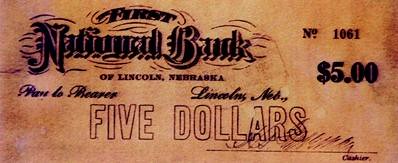
PREV ARTICLE
NEXT ARTICLE
FULL ISSUE
PREV FULL ISSUE
MORGAN, BUFFETT AND THE PANIC OF 1907 Another online item that caught my eye this week was an image of a piece of 1907 Clearing House currency I hadn't seen before. It was used to illustrate this article on the Panic of 1907 with comparison's to today's economic situation. -Editor Perhaps in part because of its agriculture-based economy, Nebraska did not seem to suffer greatly in the 1906 recession. Nevertheless, beginning in the summer of 1907 it became increasingly “impossible to obtain money at any rate of interest” and the hoarding of currency began.As the shortage of circulating money began, some economists felt the gold standard was partially to blame, which resulted in the order for the Denver mint to begin striking $80,000 in silver dollars a day. Many banks agreed, on their own initiative, to pay out no more than $100 a week per account to ward off possible bank runs. A clearing house cartel was formed to aid one of New York City’s biggest banks, but other banks began to totter, prompting J. Pierpont Morgan to bail out the Trust Company of America, the most solid of the firms in question. All this did was to bring all the other banks’ health into question.  Closer to home, the Lincoln Clearing House was formed by local bankers at the Columbia National Bank, then on the northeast corner of 12th and O streets. From this meeting came preprinted notes on the First National Bank in $1, $2, $5, $10 and $20 denominations to ease the apparent lack of circulating currency available in the city. Five dollar notes on the First National Bank of Bradshaw carried the imprint that they “will be accepted by any bank in York County.” The First Farmers State Bank of Amherst “issued scrip and continued operation as usual,” while the Commercial Bank of Wausa quietly printed and distributed $5 and $10 “notes.” Nebraska banks issued these notes from October through November, and some had public burning ceremonies when they were redeemed. Scrip was used by hundreds of banks in 41 states. It also was used by businesses for payrolls, retail firms and even cities, almost always in preprinted standard denominations so they could be recirculated for a stated period of time or until the panic subsided. Because the federal government stepped in to aid the largest banks, it is tempting to compare the 1907 panic to the current economic recession. Some are also quick to point out the similarities between J.P. Morgan and Warren Buffett, whose Berkshire Hathaway is one of the largest investors in Wells Fargo Bank and the infusion of a reported $8 billion in Goldman Sachs and General Electric. One major difference, however, is that the current downturn will obviously not end in a mere two months. To read the complete article, see: Jim McKee: Morgan, Buffett and The Panic of 1907 (http://journalstar.com/articles/2009/06/20/news/ nebraska/doc4a3a9232b3e4f634728182.txt) Wayne Homren, Editor The Numismatic Bibliomania Society is a non-profit organization promoting numismatic literature. See our web site at coinbooks.org. To submit items for publication in The E-Sylum, write to the Editor at this address: whomren@gmail.com To subscribe go to: https://my.binhost.com/lists/listinfo/esylum All Rights Reserved. NBS Home Page Contact the NBS webmaster 
|